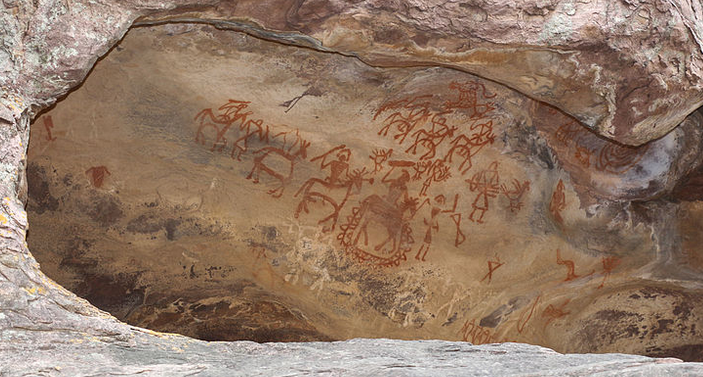Prehistoric Age
Prehistoric Age in India
Prehistoric Age refers to the time where there was no writing and development. It consists of five period – Paleolithic, Mesolithic, Neolithic, Chalcolithic & Iron Age
Prehistoric Periods in India – According to Tools
Ancient history can be divided into different periods according to the tools used by people then.
- Paleolithic Period: 2 million BC – 10,000 BC
- Mesolithic Period: 10,000 BC – 8000 BC
- Neolithic Period: 8000 BC – 4000 BC
- Chalcolithic Period: 4000 BC – 1500 BC
- Iron Age: 1500 BC – 200 BC
Prehistoric Period – Palaeolithic Period (Old Stone Age)
This is further divided into three:
- Lower Palaeolithic Age: up to 100,000 BC
- Middle Palaeolithic Age: 100,000 BC – 40,000 BC
- Upper Palaeolithic Age: 40,000 BC – 10,000 BC
Lower Palaeolithic age
- Hunters and food gatherers; tools used were axes, choppers and cleavers.
- One of the earliest lower Palaeolithic sites is Bori in Maharashtra.
- Limestone was also used to make tools.
- Major sites of lower Palaeolithic age
- Soan valley (in present Pakistan)
- sites in the Thar Desert
- Kashmir
- Mewar plains
- Saurashtra
- Gujarat
- Central India
- Deccan Plateau
- Chotanagpur plateau
- North of the Cauvery River
- Belan valley in UP
- There are habitation sites including caves and rock shelters.
- An important place is Bhimbetka in Madhya Pradesh.
Middle Palaeolithic age
- Tools used were blades, pointers, scrapers and borers.
- The tools were smaller, lighter and thinner
- Important middle Palaeolithic age sites
- Belan valley in UP
- Luni valley (Rajasthan)
- Son and Narmada rivers
- Bhimbetka
Upper Palaeolithic age
- Emergence of Homo sapiens
- A lot of bone tools, including needles, harpoons, blades, fishing tools and burin tools.
- Major sites of Upper Palaeolithic age
- Belan
- Son
- Chota Nagpur plateau (Bihar)
- Maharashtra
- Orissa and
- The Eastern Ghats in Andhra Pradesh
- Paintings at Bhimbetka site belong to this age.

Prehistoric Period – Mesolithic Period (Middle Stone Age)
- Major climate change happened.
- Climate became warmer and more humid.
- Rainfall increased and so more availability of flora and fauna.
- Domestication of animals and plants were seen for the first time.
- Started 12000 years ago.
- First animal to be domesticated was the wild ancestor of the dog.
- Sheep and goats were the most common domesticated animals.
- Hunting and food gathering continued.
- First human colonization of the Ganga plains.
- Microliths have been excavated.
- They are small stone tools that were probably stuck to stones to be used as saws and sickles.
- Major sites:
- Brahmagiri (Mysore)
- Narmada
- Vindhya
- Gujarat
- UP
- Sojat (Rajasthan)
- Bhimbetka
- Godavari Basin
- Sarai Nahar Rai
- Tools used were blades, crescents, triangles, trapezes, spearheads, knives, arrowheads, sickles, harpoons and daggers.[/su_box]
Prehistoric Period – Neolithic Period (New Stone Age)
- Starting of agriculture
- Moving from nomadic to settled life
- Wheel discovered. Ragi, wheat and horse gram were cultivated
- They knew to make fire
- Knew pottery
- Also, shows first intentional disposal of the dead
- Important sites:
- Inamgaon
- Burzahom (Kashmir)
- Mehrgarh (Pakistan)
- Daojali Hading (Tripura/Assam)
- Hallur (AP)
- Paiyampalli (AP)
- Chirand (Bihar)
- Evidence of houses[/su_box]
Prehistoric Period – Chalcolithic Period (Copper Age/Bronze Age)
Indus Valley Civilization (2700 BC – 1900 BC)
- Other settlements at
- Brahmagiri Navada Toli (Narmada region)
- Chirand (Ganga region) and
- Mahishadal (West Bengal)[/su_box]
Prehistoric Period – Iron Age
- Arrival of the Aryans: Vedic Period
- Jainism, Buddhism
- Mahajanapadas: the first major civilisation on the banks of the river Ganga after the Indus Valley.
Comments
Post a Comment